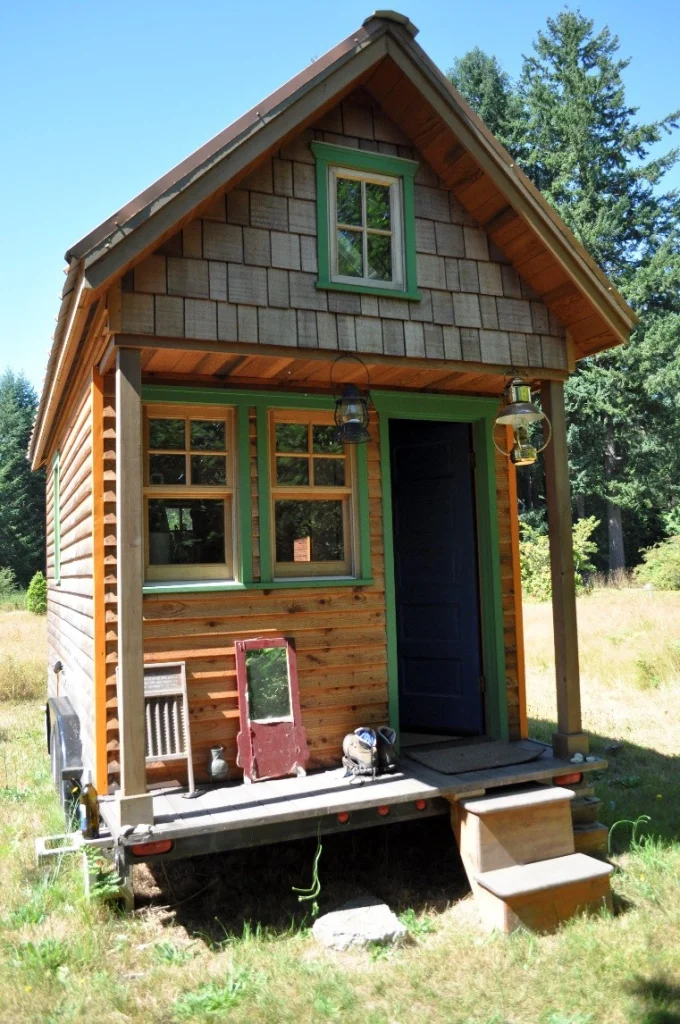
Cost has always been a big reason to pick a compact home. Today, though, less really is more.
New generations of home buyers seek out small homes for a range of reasons — like a preference for uncluttered minimalism. Or a goal of reducing their footprint on nature.
Appropriately designed small homes can be easier on people with mobility issues. Smaller homes mean lower taxes. They use heating and air conditioning efficiently. They cost less to clean. It’s easier to find misplaced things!
What’s the latest in compact living? Take a look.
Origami-Inspired Living and Working Spaces
Ori Living works with developers in Chicago, New York City, and other places where space is a scarce commodity. The design company provides homes with fold-up interior features, so even a 200-square-foot space feels roomy.
Sliding walls, folding bedrooms with king size beds that lift up into the ceiling when not needed, closets that fade out of sight, hidden offices…
The resident can adapt a room to the moment’s use, without relying on their own muscle power to move furnishings.
Origami is the Japanese art of paper folding that we learned back in our school days. The most interesting aspect of an origami room concept, other than its artistic flair? It presents a “tool to build more housing.” That’s got our attention. Ori Living focuses on “innovations to make density possible and palatable” which may just be key to adding housing to cities in an attractive form.
Detached, Not Disengaged

If given our druthers, most of us would pick a detached home to live in. Condos and townhomes have a vital place in the housing stock, yet small cottages and clusters of tiny homes have a special appeal: no shared walls.
Looking for less space in a standalone home doesn’t mean shunning the mainstream U.S. housing market. Homes are becoming smaller overall. Nationwide, newly built homes now average just under 2,200 feet. Today’s typical starter home buyer is getting some 4% less footage than their parents did.
The cost of construction is lower when a builder works with smaller dimensions. And builders can construct a good number of small homes at once. That’s helpful. The nation needs millions of housing units to meet the current demand for starter homes.
These Prefab Homes Are Fab: Little Charmers Under $300K
A prefabricated (“prefab”) home can be delivered in an assembled state, equipped with bathrooms, kitchens, and plumbing systems. Because you already need to own a space to put one, the low cost of a prefab home can’t really be compared against a home on a plot of land. Some buyers use these as guest homes or in-law cottages.
A few examples include these, noted in a recent lineup published by House Beautiful:
- Speaking of artistic design, a 2-BR trailer from New Frontier comes with a chef’s kitchen for under $300K. “Downsize and upgrade” is the company slogan.
- Modal OO homes are small yet lofty units that ship nationwide. These also start at less than $300K.
- Need durability in a rugged climate? Modular homes, which are delivered and moved with a crane and flatbed truck, can now feature protection from earthquakes, harsh weather, even typhoons. And they’re available for well under $100K — a fraction of the cost of a traditional, detached house.
The list goes on. We can even order prefab homes from Amazon.com these days.
Selling Like a Lot of Little Hotcakes
As Lance Lambert of ResiClubAnalytics.com observes, “We are in a historically significant chapter for housing, one that has witnessed affordability deteriorate to levels unseen in decades.” So big developers like Lennar have jumped on the less-is-more bandwagon. They’re selling homes for under $200K in areas where the average home goes for double the price.
Small home developments are filling up. Just take note: Companies advertise that they’re stepping up to fill demand for housing that’s lower cost, yet upscale. Yet some developers’ marketing materials don’t provide the real feel for the cookie-cutter reality they offer.
Small home communities can be perfectly great places to live. And perfectly great way to get “on the ladder” and start building home equity. Just be sure to check out photos on review sites while doing any initial home hunting!
You’ll also want to know that some of these companies work with specific lenders to help buyers acquire their homes. Find out about financing relationships in advance. Consider the lending businesses’ online reviews.
What Are the Potential Drawbacks to Compact Living?
Much depends what you count as necessities. Homes under 1,000 square feet may or may not have full-sized appliances. And of course prefab homes come without garages.
Purchasing a site and buying a tiny home on wheels with an RV loan can be worthwhile. The buyer achieves the feel of a compact apartment, but with outdoor space that belongs to the deed holder. And the monthly housing costs could be far lower than area average rents. Once the loan is paid off, the bulk of the monthly costs will be the property taxes. While this lifestyle can save the buyer quite a bit of money, note that the home won’t appreciate in value as a house would.
People with kids will need to look at the larger end of the small-home spectrum. They’ll want to be sure there is privacy for everyone.
And although the homes come assembled, be sure to prepare for the time and process of installing the home on its new site.
With any of the prefab designs, the buyer will need to study local zoning and permitting requirements, and speak with the company to research a good plan for siting the home before placing an order. Even if the buyer is looking to place a tiny home on family-owned land, there are utility hookup rules that could derail the plan.
Accentuating the Positive
As you can see, due diligence is different with a modular home. That said, it looks like the modular home trend won’t become old any time soon. The demand for the cozy cottage is expected to continue, according to home designers.
And no wonder. The cost of housing is a concern for most people everywhere. Has there ever been a better time to normalize the scaled-down home?
With a positive mindset, the successful buyer can make the most of a compact floorplan. And expecting less space is fashionable. Even House Beautiful says “tiny homes are everywhere right now.”
Supporting References
Maurie Backman for U.S. News & World Report: Are Homes Getting Smaller? (Oct. 15, 2024).
David Pogue for CBS News from CBS Broadcasting Inc.: From Mansion to Studio, There’s No Place Like Home (May 21, 2023).
AJ LaTrace for Real Estate News: Industry – Why Buyers Are Gravitating Toward Smaller Homes (Nov. 29, 2024).
Janae McKenzie, with Meghan Shouse and Kate McGregor, for House Beautiful (part of Hearst Magazine Media, Inc.): 14 Prefab Tiny Homes That Are So Easy to Install (Dec. 10, 2024).
And as linked.
More on topics: Local rules evolve to include tiny homes, Finding and buying a tiny home
Photo credits: Daeva Trạc / Wikimedia Commons, licensed as CC-BY-SA 4.0 International (cropped), and Tammy / Flickr via Wikimedia Commons, licensed as CC-BY-SA 2.0.
